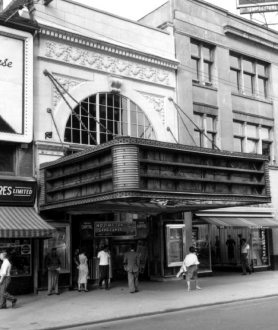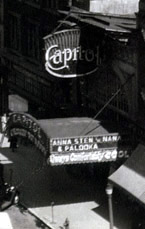THE HEART OF THE CITY
LOEWS AND
CAPITOL THEATRES
103 King Street East
 CURRENT STATUS (1999)
CURRENT STATUS (1999)
Present Owner: 1136116 Ontario Ltd., Ancaster
Present Use: Joe
Buttinsky’s Bar and Wing Joint
Heritage Status: Listed
on the City’s Inventory of Buildings of Architectural and/or Historical Interest
 BUILDING INFORMATION
BUILDING INFORMATION
Date Built: 1917
Original Owner: Marcus
Loew, American theatre / hotel magnate (building owner); Mills Bros. (land owner)
Original Use: Loew’s
Theatre (vaudeville and moving pictures)
Subsequent Uses: Theatre
name changed to the Capitol in 1922 and closed in 1971; auditorium subsequently demolished
and front section preserved and converted to a restaurant
Previous Building on Site: Unknown to present
 ARCHITECTURE
ARCHITECTURE
Size: Frontage: 22.61 ft.; height: two storeys
Design and Style: Early
twentieth century transitional
Architect, Builder: Thomas
W. Lamb (architect, New York); P.H. Secord & Son (contractor)
Construction Materials: Fašade: limestone
Architectural Integrity: Fašade: moderate (limestone fašade largely intact; original entrance
altered and cornice removed)
Architectural Features: Opulent fašade characteristic of early twentieth century vaudeville
theatres and movie palaces: large semi-circular "Sullivanesque" window (now
covered by a hemispherical canopy) framed by a classically inspired composition of
pilasters, a bracket-like keystone over the round arch, and a low-relief frieze panel with
a row of modillions above (originally surmounted by a widely projecting cornice); entrance
originally featured a large suspended illuminated sign marquee (removed when entrance was
remodelled in 1958)
 The Loew’s theatre, which would later be known
as the Capitol theatre, opened on New Year’s Eve in 1917. That night stood as an
example to the popularity of the theatre: 1500 people remained in line for tickets despite
a sold out show. The theatre, erected by the Loew’s Corporation, and designed by
Thomas W. Lamb, an architect of international fame known for designing Radio City Music
Hall in New York, cost 225,000. It stood as the 218th theatre in the
Loew’s chain, and was Hamilton’s largest theatre. The Loew’s Theatre stood
as Canada’s second largest theatre for the longest time.
The Loew’s theatre, which would later be known
as the Capitol theatre, opened on New Year’s Eve in 1917. That night stood as an
example to the popularity of the theatre: 1500 people remained in line for tickets despite
a sold out show. The theatre, erected by the Loew’s Corporation, and designed by
Thomas W. Lamb, an architect of international fame known for designing Radio City Music
Hall in New York, cost 225,000. It stood as the 218th theatre in the
Loew’s chain, and was Hamilton’s largest theatre. The Loew’s Theatre stood
as Canada’s second largest theatre for the longest time.
The theatre, luxuriously decorated and furnished, had a seating capacity of 2,268, and
was known for showing silent movies featuring such stars as Charlie Chaplan and William S.
Hart. The chairs were covered in heavy green Russian leather. The lobby floor was made
from marble, had brilliant lighting, large plate glass mirrors, and photographs of the monarchy
decorating the walls. The orchestra pit and balconies were covered in gorgeous, deep
rose-coloured carpets. There was a rich velour canopy, lined with gold fringe and
decorated with the Ontario Coat of Arms in the centre, which rested over the curtain. An
engulfing dome of coloured stained glass served as a skylight. An open water well stood in
the foyer where theatre patrons would throw in coins before entering the orchestra pit.
The exterior of the theatre had an enormous canopy that stretched over the crowd. There
were continuous performances between one thirty and eleven in the evening.
glass mirrors, and photographs of the monarchy
decorating the walls. The orchestra pit and balconies were covered in gorgeous, deep
rose-coloured carpets. There was a rich velour canopy, lined with gold fringe and
decorated with the Ontario Coat of Arms in the centre, which rested over the curtain. An
engulfing dome of coloured stained glass served as a skylight. An open water well stood in
the foyer where theatre patrons would throw in coins before entering the orchestra pit.
The exterior of the theatre had an enormous canopy that stretched over the crowd. There
were continuous performances between one thirty and eleven in the evening.
In 1922, the theatre was taken over by the Hamilton Theatre, and the shareholders of
Hamilton Theatre Limited (Pantage Theatre). These two groups voted to unite the two
theatres under a central management. The controlling company was to be known as the
Hamilton United Theatres Limited. As the Pantage shareholders held the majority of the
stock, they were named form the board of directors. The theatre, under new management was
to be known as the Capitol Theatre, and reopened in September 1922.
In 1926, an organ was brought into the Capitol after serving a Winnipeg Church for
years. There were 1,300 pipes fabricated in  Woodstock. The Organ took nearly six months to
install. The Capitol theatre now showed educational films, news, comedies, cartoons, and
musicals. This theatre was to become a motion picture theatre as the demand for large
theatrical presentations and vaudeville died following the arrival of "talkies".
Some of the movies shown include: "The Guns of Navarone", "The Eddie Duchin
Story", "An Affair to Remember", and the "Al Jolson Story". Each
day, after the showing of the last film, a midnight rock show was presented.
Woodstock. The Organ took nearly six months to
install. The Capitol theatre now showed educational films, news, comedies, cartoons, and
musicals. This theatre was to become a motion picture theatre as the demand for large
theatrical presentations and vaudeville died following the arrival of "talkies".
Some of the movies shown include: "The Guns of Navarone", "The Eddie Duchin
Story", "An Affair to Remember", and the "Al Jolson Story". Each
day, after the showing of the last film, a midnight rock show was presented.
In 1930, the Capitol was taken over by Canadian Famous Players Corporation and remained
in their control until 1946, when it was turned over to the Canadian Odeon Theatre Chain.
In 1958, the steel canopy of the Capitol, which had been in place since 1917, was torn
down as a result of a general renovation project. The limestone front was sandblasted and
a thirty-inch canopy, which had a hidden series of light in it, replaced the old canopy.
On August 31, 1971, movie operations ceased – it was a sign that an era had come
to an end. On January 10, 1973, demolition of the theatre commenced. Many of the items
were sold on auction. The rear portion was torn down and replaced with a parking lot and
the front portion of the theatre was transformed into stores.
View the seating plan
REFERENCES:
Clipping File – Hamilton – Motion Pictures
Theatres-the Capitol. Special Collections. HPL.
Clipping File-Hamilton-Burlesque. Special Collections. HPL.
Clipping File-Hamilton-Motion Pictures theatre-Odeon. Special Collections. HPL.
Clipping File-Hamilton –Organizations and societies-Hamilton Area Theatre Organ
Society. Special Collections. HPL.
Hamilton News Scrapbook, Volume M4. Special Collections. HPL.
Hamilton Cue, June 84. Special Collections. HPL.
Loew’s theatre. Special Collections. HPL.
Our Heritage Scrapbook. Special Collections. HPL.

![]() CURRENT STATUS (1999)
CURRENT STATUS (1999)
![]() BUILDING INFORMATION
BUILDING INFORMATION![]() ARCHITECTURE
ARCHITECTURE The Loew’s theatre, which would later be known
as the Capitol theatre, opened on New Year’s Eve in 1917. That night stood as an
example to the popularity of the theatre: 1500 people remained in line for tickets despite
a sold out show. The theatre, erected by the Loew’s Corporation, and designed by
Thomas W. Lamb, an architect of international fame known for designing Radio City Music
Hall in New York, cost 225,000. It stood as the 218th theatre in the
Loew’s chain, and was Hamilton’s largest theatre. The Loew’s Theatre stood
as Canada’s second largest theatre for the longest time.
The Loew’s theatre, which would later be known
as the Capitol theatre, opened on New Year’s Eve in 1917. That night stood as an
example to the popularity of the theatre: 1500 people remained in line for tickets despite
a sold out show. The theatre, erected by the Loew’s Corporation, and designed by
Thomas W. Lamb, an architect of international fame known for designing Radio City Music
Hall in New York, cost 225,000. It stood as the 218th theatre in the
Loew’s chain, and was Hamilton’s largest theatre. The Loew’s Theatre stood
as Canada’s second largest theatre for the longest time. glass mirrors, and photographs of the monarchy
decorating the walls. The orchestra pit and balconies were covered in gorgeous, deep
rose-coloured carpets. There was a rich velour canopy, lined with gold fringe and
decorated with the Ontario Coat of Arms in the centre, which rested over the curtain. An
engulfing dome of coloured stained glass served as a skylight. An open water well stood in
the foyer where theatre patrons would throw in coins before entering the orchestra pit.
The exterior of the theatre had an enormous canopy that stretched over the crowd. There
were continuous performances between one thirty and eleven in the evening.
glass mirrors, and photographs of the monarchy
decorating the walls. The orchestra pit and balconies were covered in gorgeous, deep
rose-coloured carpets. There was a rich velour canopy, lined with gold fringe and
decorated with the Ontario Coat of Arms in the centre, which rested over the curtain. An
engulfing dome of coloured stained glass served as a skylight. An open water well stood in
the foyer where theatre patrons would throw in coins before entering the orchestra pit.
The exterior of the theatre had an enormous canopy that stretched over the crowd. There
were continuous performances between one thirty and eleven in the evening. Woodstock. The Organ took nearly six months to
install. The Capitol theatre now showed educational films, news, comedies, cartoons, and
musicals. This theatre was to become a motion picture theatre as the demand for large
theatrical presentations and vaudeville died following the arrival of "talkies".
Some of the movies shown include: "The Guns of Navarone", "The Eddie Duchin
Story", "An Affair to Remember", and the "Al Jolson Story". Each
day, after the showing of the last film, a midnight rock show was presented.
Woodstock. The Organ took nearly six months to
install. The Capitol theatre now showed educational films, news, comedies, cartoons, and
musicals. This theatre was to become a motion picture theatre as the demand for large
theatrical presentations and vaudeville died following the arrival of "talkies".
Some of the movies shown include: "The Guns of Navarone", "The Eddie Duchin
Story", "An Affair to Remember", and the "Al Jolson Story". Each
day, after the showing of the last film, a midnight rock show was presented.